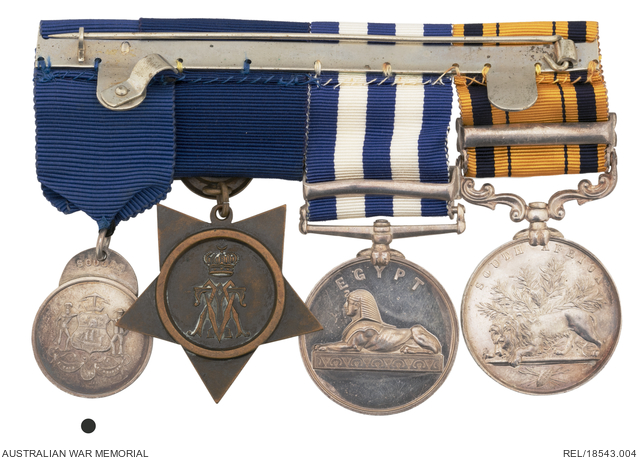| Places | |
|---|---|
| Accession Number | REL/18543.004 |
| Collection type | Heraldry |
| Object type | Medal |
| Physical description | Silver |
| Maker |
Unknown |
| Place made | Australia: New South Wales, Sydney |
| Date made | c 1886 |
| Conflict |
Sudan, 1885 |
| Source credit to | This item has been digitised with funding provided by Commonwealth Government. |
Mayor of Sydney's Soudan Medal : Staff Surgeon U G D Glanville, NSW Sudan Contingent




Mayor of Sydney's Silver Soudan Medal. The obverse shows the coat of arms for Sydney. Above it, on a solid semi-circular suspender pierced to take a ribbon, is the word 'SOUDAN'. The reverse bears raised lettering around the edge 'PRESENTED BY THE CITIZENS OF SYDNEY. T.PLAYFAIR, MAYOR, 1885.', and in the centre the recipient's details surrounded by a raised laurel wreath. The medal is fitted with a small loose ring suspender and mounted on a piece of 30 mm dark blue ribbon.
Usher Glanville Doyle Glanville was born at Brighton, Sussex, UK on 31 October 1844. After completing his medical education he joined the Union Steamship Company as a medical officer. In 1879 he joined the British Army and was attached to Colonel Durnford's column of 2000 men in South Africa of whom the majority were killed by the Zulu at Isandalwana. Dr Glanville escaped the massacre, along with 30 others, who had been ordered to march the night previously, as a member of a reconnaissance party three miles away. He was later present at the Battle of Ulundi where he was mentioned in despatches by Sir Evelyn Wood for distinguished service. Dr Glanville was then attached to the 1st King's Dragoon Guards, Lord Wolseley's military escort, and proceeded with them through the Transvaal. He was present when the body of the French Prince Imperial was found in Zululand. At the end of the campaign in South Africa he returned the Merchant Marine serving as surgeon in SS Rome. In 1885 he offered his services as a medical officer with the New South Wales Contingent to the Sudan and travelled to Egypt in SS Australia with the rank of Captain. Glanville is known for the sketches he made on board which were printed in the Illustrated Sydney News. He returned to Australia with the contingent and served briefly with Major-General Sir Peter Scratchley, the newly appointed Commissioner for New Guinea. In 1886 he was accepted as a Fellow of the Royal Geographical Society and in the same year was registered in Victoria as a medical practitioner. Dr Glanville was again in Africa in 1890 as a Colonial Government Medical Officer and sent sketches back to the Illustrated London News. In 1891 he died of fever while escorting three Red Cross nurses from the east coast of South Africa, up the Pungwe River to Mashonaland to the gold-fields of the present-day Zimbabwe.